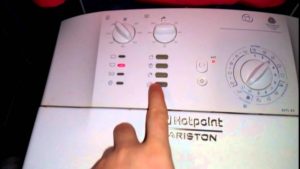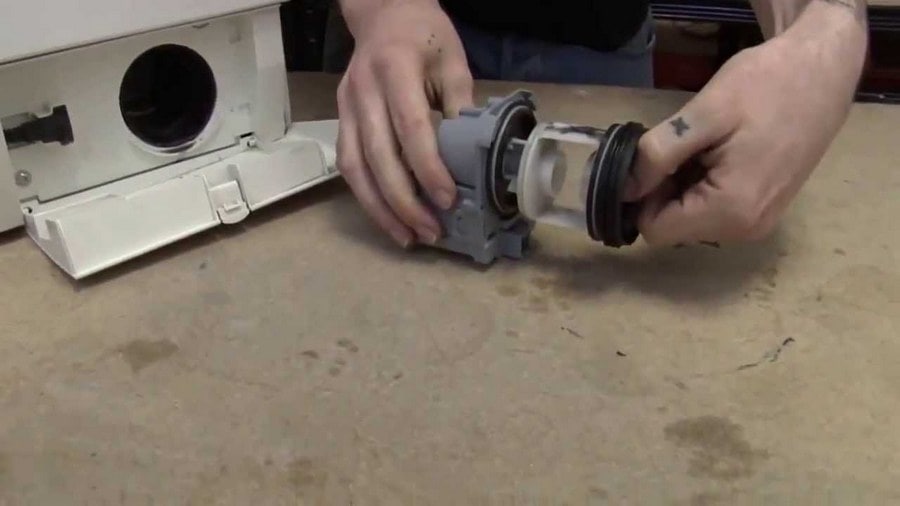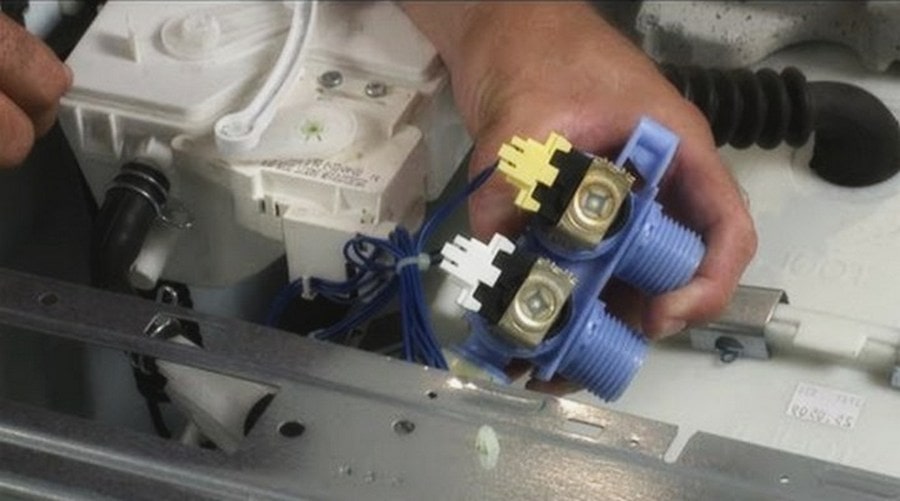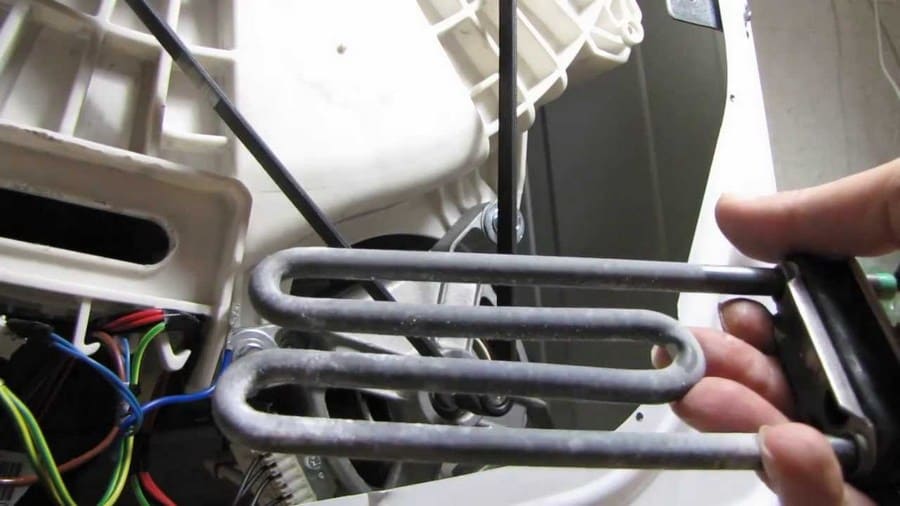 Washing machines from any manufacturer, including Ariston, break down from time to time. This occurs due to long periods of operation, careless handling, voltage surges and many other reasons. Usually, the owner of the equipment can fix the malfunctions of the Ariston washing machine with his own hands; only some breakdowns are so complex that it is worth calling a specialist from the service center for repairs.
Washing machines from any manufacturer, including Ariston, break down from time to time. This occurs due to long periods of operation, careless handling, voltage surges and many other reasons. Usually, the owner of the equipment can fix the malfunctions of the Ariston washing machine with his own hands; only some breakdowns are so complex that it is worth calling a specialist from the service center for repairs.
Types of faults
Today, the most common malfunctions of Ariston washing machines, both front-loading and top-loading, are:
- Blockages in the water drainage system.
- Defective pump or water intake valve.
- Failure of the heating element.
- Bearing wear.
- Control board error.
Other breakdowns also occur, but they occur much less frequently. Typically, the washing machine indicates a malfunction by displaying a special code on the screen or by flashing indicators in a certain sequence. To understand exactly which node inside the device requires attention, you need to open the user manual and see how the error codes are deciphered.
Pump removal and repair

If after washing the machine tries to drain the water, the pump hums and works, but the water does not drain, this indicates a blockage in its path. This malfunction appears at the end of the program, when the equipment should drain and start rinsing, but freezes because the water does not drain or the drain is very slow.
Blockages appear in the following places:
- Drain filter.
- The pipe connecting the filter and the tank.
- Water pump.
- Drain hose.
Usually the clog appears in the filter. This happens much less frequently in the pipe (it has a large diameter), in the pump (an auxiliary filter is installed in front of it), and also in the hose (only if it is installed incorrectly).
Repairs should begin in easily accessible places. First you need to open the base panel, unscrew the filter, remove accumulated debris and install the part in its original place. Next, you need to lay the Ariston washing machine on its side, loosen the clamps, remove and clean the drain pipe. After this, you need to inspect the pump. Some dirt particles may pass through the filter and clog it thoroughly. The part should be disassembled, cleaned thoroughly, and if it is damaged, replace it with a new one. The procedure for disassembling, cleaning and replacing the pump is as follows:
- Disconnect the washing machine from the network and communications, remove the back cover.
- Place the equipment on its left side so that the pump is on top.
- Unscrew the fasteners holding the pump.
- Disconnect the pipes going to the unit and drain the water. Disconnect the wiring.
- Replace the faulty part with a new one.
- Connect the pump and assemble the washing machine.
The last thing you need to do is inspect and clean the drain hose with a plumbing cable. It gets clogged extremely rarely.
Water inlet valve malfunction

If the filling valve of an Ariston washing machine is broken, it does not shut off the water, and it flows into the tank itself, even if the equipment is unplugged from the outlet. This malfunction can be determined by the murmur of water, which is heard when the machine is turned off. To repair the part, you must disconnect the washing machine from the network and water supply and remove the top cover.
The water inlet valve is installed at the top, in the place where the inlet hose connects to the washing machine. First, you should inspect the gaskets for integrity, and then take a multimeter, switch to resistance measurement mode and install the probes on the sensor contacts. If it is working properly, the display will show a value ranging from 30 to 50 ohms. A broken valve cannot be repaired, so the part must be replaced. The process is very simple, just disconnect the wires, unscrew the faulty element and replace it with a new one.
Broken heating element

Due to the fact that hard water is poured into the washing machine, scale forms on the heating element, as a result of which the part breaks. In case of such a breakdown, the wash is performed in cold water or the program does not start at all. To diagnose and perform repairs yourself, you must:
- Disconnect the Ariston washing machine from the network and communications, remove the back cover.
- The heating element is located at the bottom. You need to take a multimeter, switch to resistance measurement mode and install the probes on the contacts of the part. If the device is working properly, the display will show 25-30 ohms. A value of 1 ohm is reported for an open circuit, and a value of zero for a short circuit.
- To disconnect a faulty heating element, you need to unscrew the fastening bolt, disconnect the wires and, by shaking, pull the part out of the seat.
- Install the new heating element in reverse order and assemble the washing machine.
Bearings are worn out

If, during washing, the owner of the equipment hears an increasing hum, which turns into a loud knock during the spin cycle, this most likely indicates the failure of the bearings. To verify this, open the hatch and manually turn the drum. If the bearings are deformed, a strong play will be clearly felt.
This malfunction occurs as a result of prolonged use. The oil seal covering the seat and bearing dries out over time and cracks form on it. Moisture penetrates through them, washes away the lubricant, and as a result, the bearing rubs and deforms during operation.
Troubleshooting this type of fault is much more difficult than replacing a heating element or pump. To do this, the owner of an Ariston washing machine will need to completely disassemble his device and remove the tank and drum from the body.
Further repairs depend on the type of tank. Usually on washing machines of this manufacturer it is non-separable, so you will need to cut it into two halves along the seam. You should first select the bolts with which the parts of the tank will be connected during assembly and drill holes of the appropriate diameter along the seam.
Next, the faulty bearings are knocked out and new ones are installed in their place. The seals also need to be replaced.
After repair, the Ariston washing machine is assembled in the reverse order. The tank halves at the joints must be lubricated with silicone sealant to avoid leaks.
Replacing bearings is a very complex and difficult process, therefore, if you are not confident in the successful completion of the repair work, you should contact specialists.
Control board fault

The control unit most often fails due to voltage surges. To protect the washing machine from such faults, you need to connect it through a voltage stabilizer or at least a surge protector. It is very difficult to repair the control board on your own; all the user can do is order a new part and replace the faulty one with it. The repair procedure is as follows:
- Disconnect equipment from the network.
- Remove the top cover and remove the detergent container.
- Unscrew the fasteners holding the front panel.
- Release the clamps, disconnect the wiring, and remove the board.
- Install the new part and reassemble in reverse order.
Other faults
There are other types of breakdowns for Ariston Hotpoint washing machines. They appear much less frequently than those listed above, but are nevertheless characteristic of the equipment of this manufacturer.
In some cases, the user finds that the washing machine does not turn on. The cause of the breakdown should first be looked for outside the device - check for the presence of light, make sure that the machines are not knocked out, and also inspect the sockets and extension cords and make sure that they are in working order. If no problems are found, you should look for a fault in the control unit of the Ariston washing machine.
If the door of the washing machine does not close, there may be several reasons - misalignment, wear of the locking tongue, failure of the UBL. It is necessary to tighten the hinges, inspect and change the latch, unscrew the fasteners and pull out the hatch locking device, carry out diagnostics and, if necessary, replace with a new lock.
Another common malfunction for Ariston Margarita washing machines or another series is a motor breakdown.Brushes usually fail. To repair, you need to lay the equipment on its side and remove the engine. After this, you will need to replace the brushes, clean the commutator and the space between it and the lamellas. After carrying out the work, it is necessary, without putting on the belt, to start the spin cycle at initial speed. If the motor is working correctly, you need to stop the program, put on the belt and run a test wash without loading laundry.
Sometimes knocking and humming noises when the washing machine is operating are caused not by worn bearings, but by improper installation of the product. It is necessary to install the equipment level using adjustable feet, and also place shock-absorbing stands under them. They significantly reduce vibration and make washing quieter. If the washing mashine is still loud, you need to check the condition of the drive belt and shock absorbers.
How to determine a malfunction on washing machines without a display
New Ariston washing machines with a self-diagnosis system display fault codes on the screen, after which they can be deciphered using the user manual. In older series without a screen, for example, Ariston 2000, the same information is displayed using indicators. The lights flash at a certain frequency; you need to count the number of flashes in a series, and then refer to the instructions, which list all possible types of errors.
If the washing machine is not equipped with a self-diagnosis system, you can determine the malfunction by its characteristic symptoms, and then carry out repair work on your own. Otherwise, you should contact the service center. Professionals have a special diagnostic key that is inserted into a connector on the system board and uses it to read information about the state of the equipment.
Conclusion
If an Ariston washing machine breaks down, you can determine the malfunction by deciphering the blinking indicators or the error code on the screen, as well as by the accompanying symptoms that accompany the breakdown. As a rule, the user can perform most of the repair work on his own. You should turn to professionals for help only in the most difficult cases, for example, to repair the central board or when there is no confidence in the successful completion of the equipment repair work.









